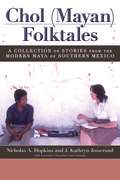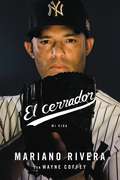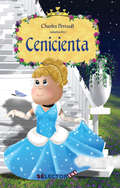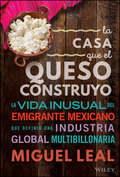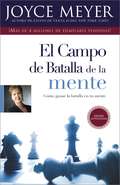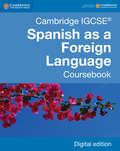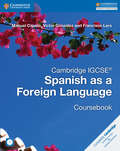- Table View
- List View
Chol (Mayan) Folktales: A Collection of Stories from the Modern Maya of Southern Mexico
by Nicholas A. Hopkins J. Kathryn JosserandChol (Mayan) Folktales deftly combines high-quality and thoughtfully edited transcriptions of oral storytelling with translation and narrative analysis, documenting and analyzing a trove of Chol folklore. The work provides a look into the folktale culture of the contemporary Maya presented with a rare and innovative theoretical framework. The rich Chol oral narrative tradition is represented by eleven stories, each printed in the original language of the storytellers with parallel English translations and accompanied by a brief introduction that provides the relevant cultural and mythological background. Included with eight of the stories is a link to an audio clip of the tale told aloud in the Chol language. In addition, Chol (Mayan) Folktales introduces a model for the analysis of narratives that can be used to demonstrate the existence of a tradition of storytelling applicable to other Maya lore, including Classic period hieroglyphic texts. Creating a nuanced sense of the Mayan oral tradition and revealing a highly structured literary style, this collection provides insight into contemporary Maya culture as well as a greater understanding of Classic period society. It will be of interest to students and scholars of folklore and literature and to anthropologists and linguists.
El cerrador: Mi vida
by Mariano RiveraThe greatest relief pitcher of all time shares his extraordinary story of survival, love, and baseball. Mariano Rivera, the man who intimidated thousands of batters merely by opening a bullpen door, began his incredible journey as the son of a poor Panamanian fisherman. When first scouted by the Yankees, he didn't even own his own glove. He thought he might make a good mechanic. When discovered, he had never flown in an airplane, had never heard of Babe Ruth, spoke no English, and couldn't imagine Tampa, the city where he was headed to begin a career that would become one of baseball's most iconic. What he did know: that he loved his family and his then girlfriend, Clara, that he could trust in the Lord to guide him, and that he could throw a baseball exactly where he wanted to, every time. With astonishing candor, Rivera tells the story of the championships, the bosses (including The Boss), the rivalries, and the struggles of being a Latino baseball player in the United States and of maintaining Christian values in professional athletics. The thirteen-time All-Star discusses his drive to win; the secrets behind his legendary composure; the story of how he discovered his cut fastball; the untold, pitch-by-pitch account of the ninth inning of Game 7 in the 2001 World Series; and why the lowest moment of his career became one of his greatest blessings. In The Closer, Rivera takes readers into the Yankee clubhouse, where his teammates are his brothers. But he also takes us on that jog from the bullpen to the mound, where the game -- or the season -- rests squarely on his shoulders. We come to understand the laserlike focus that is his hallmark, and how his faith and his family kept his feet firmly on the pitching rubber. Many of the tools he used so consistently and gracefully came from what was inside him for a very long time -- his deep passion for life; his enduring commitment to Clara, whom he met in kindergarten; and his innate sense for getting out of a jam. When Rivera retired, the whole world watched -- and cheered. In The Closer, we come to an even greater appreciation of a legend built from the ground up.
El cerrador: Mi vida
by Mariano RiveraThe greatest relief pitcher of all time shares his extraordinary story of survival, love, and baseball. Mariano Rivera, the man who intimidated thousands of batters merely by opening a bullpen door, began his incredible journey as the son of a poor Panamanian fisherman. When first scouted by the Yankees, he didn't even own his own glove. He thought he might make a good mechanic. When discovered, he had never flown in an airplane, had never heard of Babe Ruth, spoke no English, and couldn't imagine Tampa, the city where he was headed to begin a career that would become one of baseball's most iconic. What he did know: that he loved his family and his then girlfriend, Clara, that he could trust in the Lord to guide him, and that he could throw a baseball exactly where he wanted to, every time. With astonishing candor, Rivera tells the story of the championships, the bosses (including The Boss), the rivalries, and the struggles of being a Latino baseball player in the United States and of maintaining Christian values in professional athletics. The thirteen-time All-Star discusses his drive to win; the secrets behind his legendary composure; the story of how he discovered his cut fastball; the untold, pitch-by-pitch account of the ninth inning of Game 7 in the 2001 World Series; and why the lowest moment of his career became one of his greatest blessings. In The Closer, Rivera takes readers into the Yankee clubhouse, where his teammates are his brothers. But he also takes us on that jog from the bullpen to the mound, where the game -- or the season -- rests squarely on his shoulders. We come to understand the laserlike focus that is his hallmark, and how his faith and his family kept his feet firmly on the pitching rubber. Many of the tools he used so consistently and gracefully came from what was inside him for a very long time -- his deep passion for life; his enduring commitment to Clara, whom he met in kindergarten; and his innate sense for getting out of a jam. When Rivera retired, the whole world watched -- and cheered. In The Closer, we come to an even greater appreciation of a legend built from the ground up.
La Cenicienta
by Charles PerraultCon la historia de Cenicienta una hermosa niña que como premio a su bondad recibió muchos regalos de su hada madrina comenzamos la serie Princesitas. En esta serie viviremos los sueños de tantas niñas que como tú aprendieron que todo lo que deseamos puede convertirse en realidad. Adéntrate en estas páginas y acompaña a Cenicienta en sus alegrías y tristezas asiste al baile y cálzate las zapatillas para bailar con el príncipe como ella. Verás que convertirte en una princesa puede ser más fácil de lo que te imaginas. iQuizá tu hada madrina ya esté esperando conocerte!
La Celestina
by Fernando De RojasLa Celestina, figura central de la tragicomedia de Calixto y Melibea, se edita en la frontera de los siglos XV y XVI. El éxito de la obra fue inmenso, dado el número de ediciones y traducciones que de ella se hicieron, así como su repercusión en otras obras posteriores. La Celestina se presenta con una estructura trágica, dramática, donde el amor como pasión irrefrenable es el motor que pone en marcha la obra.
La cautiva
by Esteban Echeverría"La cautiva" esun poema escrito en 1837, en el que el autor cuenta la fuga de un matrimonio blanco de un campamento indio. La Cautiva constituye el poemario más valioso de todos los publicados por Echeverría, contiene un poema largo que consta de nueve partes.
El castillo
by Franz KafkaFranz Kafka (1883-1924) comienza a escribir EL CASTILLO muy probablemente en enero de 1922; en septiembre de ese mismo año abandona el manuscrito, editado poco después de su muerte por Max Brod. En la novela son facilmente perceptibles los elementos autobiográficos, y reconocible la localización geográfica; según muchos críticos, es el proyecto literario más ambicioso y logrado de Kafka. El agrimensor K. acude a una aldea, cuya vida gira por entero en torno al castillo que la gobierna, a fin de incorporarse a un trabajo para el que cree ha sido llamado; todo el relato ocupa la historia de sus inútiles esfuerzos para aclarar su situación y romper el círculo de soledad que le rodea. El clima y la idea dramática son análogos a los que informan "La metamorfosis", "El proceso" y, en general, su obra entera: un mundo exterior que pese a conservar todas las notas que lo hacen fisonómicamente reconocible y familiar, es objeto de una misteriosa mutación que la transforma cualitativamente; una secuencia de acontecimientos incomprensibles para quien la padece pero que esconde tras la aparente arbitrariedad de su movimiento una necesidad ineluctable; la inoperancia de la voluntad y el entendimiento humanos para comprender ese medio hostil y doblegarlo.
Castellanas
by José María Gabriel y GalánEl libro de CASTELLANAS fue el primero que el poeta dio a la imprenta en el año 1901. Se trata de un volumen con 17 poesías en donde, -a pesar del título- contiene poesías de ambiente campesino de su época castellana, pero también contiene algunas poesías de claro ambiente extremeño. El libro NUEVAS CASTELLANAS fue el tercero en dar a la imprenta el poeta y contiene un total de 22 poesías. El ambiente que respiran todas ellas, también está impregnado de aromas castellanos y extremeños, y son la más genuina expresión de todo el conjunto de su obra poética.
La Casa Que El Queso Construyo: Vida Inusual Del Emigrante Mexicano Que Definio Una Industria Global Multibillonaria
by Miguel A. LealA quintessential American dream story from a Mexican entrepreneur who shares the tale of building a multi-million-dollar business from scratch, complete with both success and failure, and always a vision of hope Leal came to the U.S. penniless as a teenager, speaking almost no English; he literally slept in the boiler room of a Wisconsin cheese factory for months before he was caught. Through hard work, grit, and ingenuity Leal would go on to launch his own business. He is widely credited with introducing Mexican cheeses to the U.S. market and grew his company to a multibillion-dollar success story. Yet, like many successful entrepreneurs, Leal’s great successes were matched by personal failures: the end of a marriage; trouble with law enforcement; and the deeply felt sense that there must be something more to life than great wealth. Leal’s memoir, THE HOUSE THAT CHEESE BUILT, is both a beautiful illustration of the immigrant experience—isolation, fear, and ambition for a better life and assimilation—as well as a thoughtful personal account of entrepreneurship and all its benefits and costs.
La Casa Que El Queso Construyo: Vida Inusual Del Emigrante Mexicano Que Definio Una Industria Global Multibillonaria
by Miguel A. LealA quintessential American dream story from a Mexican entrepreneur who shares the tale of building a multi-million-dollar business from scratch, complete with both success and failure, and always a vision of hope Leal came to the U.S. penniless as a teenager, speaking almost no English; he literally slept in the boiler room of a Wisconsin cheese factory for months before he was caught. Through hard work, grit, and ingenuity Leal would go on to launch his own business. He is widely credited with introducing Mexican cheeses to the U.S. market and grew his company to a multibillion-dollar success story. Yet, like many successful entrepreneurs, Leal’s great successes were matched by personal failures: the end of a marriage; trouble with law enforcement; and the deeply felt sense that there must be something more to life than great wealth. Leal’s memoir, THE HOUSE THAT CHEESE BUILT, is both a beautiful illustration of the immigrant experience—isolation, fear, and ambition for a better life and assimilation—as well as a thoughtful personal account of entrepreneurship and all its benefits and costs.
Cartas desde mi celda
by Gustavo Adolfo BécquerCartas que Gustavo Adolfo Bécquer escribió en el monasterio de Veruela.'Desde mi celda' ha sido considerada una obra maestra del periodismo español del siglo XIX. Formada por una serie de nueve cartas o artículos epistolares publicados en el periódico madrileño El Contemporáneo. Bécquer da en ellas amplia información sobre tipos, leyendas y creencias con el rigor de un auténtico folclorista, al mismo tiempo que proporciona amplia información sobre sí mismo y su ajetreada vida de periodista en Madrid.
Cartas
by Juana Inés de la CruzA lo largo de su vida, Sor Juana escribió gran cantidad de poemas, obras de teatro y algunos textos en prosa. Tanto en su obra como en su vida, Juana de Asbaje luchó siempre por lograr la igualdad entre el hombre y la mujer. Luchó para que la mujer tuviera derecho a la educación y se reconociera que es tan inteligente como el hombre. Por ser la mujer más destacada de su época se le dio el sobrenombre de "La décima Musa". Como también a pasado a la historia con los significativos nombres con que la crítica la ha bautizado: "Fénix de México" y "La monja Mexicana". La fama del "Fénix de México", no encontró, ni encuentra fronteras, y tres siglos después de su creación, sus poesías siguen siendo recitadas, sus obras teatrales representadas, sus ensayos y cartas leídos y estudiados. Para el crítico, historiador, filósofo y poeta mexicano Alfonso Reyes, Sor Juana es la figura más extraordinaria de la lírica hispanoamericana.
Carta sobre la tolerancia
by John Locke"La tolerancia de aquellos que disienten de otros en materia de religión se aviene tanto al Evangelio y a la razón que parece monstruoso que haya hombres tan ciegos en medio de una luz tan clara." LOCKE, John, Carta sobre la tolerancia. Locke es considerado el fundador del empirismo inglés y se estima que el Ensayo sobre el entendimiento humano(1690) es su obra capital. Pero no sólo fueron absorvidos sus esfuerzos en la teoría del conocimiento. También fue crucial su influencia en la filosofía política y en la teoría de la educación. La polémica desatada por su Carta sobre la tolerancia(1689) nos remite a un entorno sacudido por las luchas políticas y religiosas que, quizás, en algún momento, desesperaron a nuestro autor. Su antídoto es claro: la separación neta y radical entre Estado e Iglesia. Al primero le corresponde el velar por el bienestar de los ciudadanos; la Iglesia, por su parte, debe dedicarse al cuidado de las almas de sus fieles. Tolerancia en materia relgiosa y delimitación estricta del origen y funciones del poder político, establecidas en Dos tratados sobre el gobierno civil(1690). Por ellos se le colocará también en la cuna del liberalismo clásico.
El capote
by Nicolai GogolEl clásico relato de Gogol, tan estudiado por la crítica literaria desde su publicación. El análisis de este relato fue uno de los pilares sobre los que los formalistas rusos presentaron el concepto "literariedad". Con él, se referían a aquella o aquellas características de estructura y funcionamiento que convierten un texto en obra literaria. Se trata de procedimientos formales elaborados por el artista en dependencia de un elemento dominante, elemento que es -según algunos de ellos- la "función estética" (claramente distinta de otras funciones, como la comunicativa, por ejemplo). De este modo, lo que se entiende por "forma" en una obra, también adquiere significación. Es por esto que los formalistas desestiman la aplicación de la clásica dicotomía forma (pensada como equivalente a medio de comunicación del mensaje) - contenido (como equivalente a mensaje) al estudio del arte. Nikolái Gogol es un clásico de la literatura rusa. Escribió novelas, obras de teatro y cuentos cortos. Influyó en la obra de Dostoievsky. Vivió en San Petesburgo y luego en Roma, durante 22 años. En 1843 realizó un viaje a Palestina, y a su regreso un sacerdote lo convenció que su obra de ficción no tenía sentido, por lo que destruyó un número importante de sus manuscritos.
La capitana del Yucatán
by Emilio Salgari"Salgari sentía una profunda antipatía por la llamada literatura juvenil de su época, a la que hallaba "insulsa" y "llena de sentimentalismo" que no hacia sino "debilitar cada vez más a la juventud italiana" El 25 de abril se cumplieron 88 años de la muerte de Emilio Salgari, uno de los autores más leídos de todos los tiempos. Generalmente ignorado por los sectores literarios mas 'cultos', no son pocos los fanáticos de los llamados subgéneros que lo reivindican (un montón de escritores entre ellos) como una de las influencias clave en la cultura popular de los últimos noventa años. Su estilo directo, intenso y fuertemente expresivo, marcó en gran medida el lenguaje de medios como el cine, la novela de acción, el policial y muy especialmente, el estilo eminentemente visual del comic. Usualmente calificado como literatura para niños y/o adolescentes, Emilio Salgari es el responsable de varios de los mejores relatos de aventuras jamás escritos. Con su estilo narrativo, que combinaba veloces argumentos con personajes honorables y audaces, fuertemente impregnados por las ideas positivistas de la época, dio vida a uno de los héroes más formidables de todos los tiempos, Sandokán, el Tigre de la Malasia." Fernando Santullo Barrio
El Capitán Veneno
by Pedro Antonio de AlarcónUna obra clásica de la literatura española del siglo XIX Como la mayoría de las obras de Pedro de Alarcón, esta es una obra sencilla y amena, tres personajes ocupan la atención principal, una viuda, su hija y un capitán del ejército que por fortuna es rescatado por ellas de una inminente muerte. Dicho capitán se ufana de tener mal carácter y de odiar a las mujeres, y el amor conseguirá cambiar su parecer.
Un capitán de 15 años
by Julio VerneEl Pilgrim zarpa desde Nueva Zelandia hacia América del Norte. Una mujer, acompañada de su pequeño hijo, viaja a reunirse con su marido. Todo parece asegurar que la travesía será tranquila. Pero de inmediato comienza la aventura: Recogen a unos náufragos y, junto a ellos, a un perro que parece odiar al cocinero del barco. Luego, la lucha contra una feroz ballena termina con la desaparición del capitán y de los marineros. Dick Sand, grumete de sólo quince años, debe comandar la nave y conducir a los pasajeros a su destino. La traición de uno de los hombres los llevará a vivir las más difíciles situaciones antes de llegar a tierra. Sin embargo, al desembarcar deberán enfrentar peligros mucho mayores aún. Una entretenida novela, llena de acción y suspenso.
Cándido o el optimismo
by VoltaireAlgunos de sus contemporáneos consideraban a Voltaire (Francia, 1694-1778) capaz de defender en un debate a cualquiera de las partes. Otros lo creían generoso y entusiasta. Pero el factor común era reconocer que rechazaba totalmente lo irracional. Hoy se lo considera un fuerte antecedente del existencialismo de Sartre y otros filósofos del siglo XX. Cándido o El Optimismo es una fantasía filosófica en la cual un joven es educado por su mentor, Pangloss, según la ideología optimista de Leibniz, de la cual Voltaire se burlaba. Cándido sufre innumerables desdichas y, al perder la creencia de estar viviendo en "el mejor mundo posible", decide que la felicidad está en "cultivar su propio huerto".
El Campo de Batalla de la Mente: Ganar la Batalla en su Mente
by Joyce MeyerPreocupación, duda, depresión, enojo y sentimientos de condenación: todos ellos son ataques a la mente. Si los lectores sufren de pensamientos negativos, ¡pueden tomar aliento! Joyce Meyer ha ayudado a millones de personas a ganar estas batallas tan importantes. En su éxito de ventas más popular, la querida escritora y ministro muestra a los lectores cómo cambiar sus vidas cambiando sus mentes.Ella enseña cómo manejar los miles de pensamientos que las personas piensan cada día, y cómo enfocar la mente del modo en que Dios piensa. Y comparte las pruebas, tragedias y victorias finales su propio matrimonio, familia y ministerio que le llevaron a una verdad maravillosa y transformadora; y revela sus pensamientos y sentimientos a cada paso del camino.
Campesinas
by José María Gabriel y GalánJosé María Gabriel y Galán es el poeta del pueblo sencillo y campesino. Retrata en su poesía las formas de vida de esas gentes paupérrimas del medio rural de esa región extremeña que fue conocida a principios del siglo XX por su extremada pobreza. Es muy difícil hacer bellas poesías de esas situaciones de extrema pobreza y de hambre endémica, y sin embargo el ojo de atento observador de este gran poeta, supo dictar a su mano los más profundos versos que pueda inspirar la más humilde gente. En su tiempo, la poesía de Gabriel y Galán fue muy denostada por esos eruditos de las letras cultas que sólo encuentran calidad poética cuando se canta a lo acomodado, a lo opulento, a lo fatuo y a lo superfluo; y a todo ello se le dota de un lenguaje críptico, y sofisticado. Es una poesía que verso a verso, retrata a las gentes campesinas de Castilla y de Extremadura, y que desprende efluvios de la profunda y sencilla poesía construida con el lado bueno del corazón.
Cambridge IGCSE® Spanish as a Foreign Language Coursebook Digital Edition (Cambridge International IGCSE)
by Manuel Capelo Victor González Francisco LaraA flexible suite of resources providing full coverage of the Cambridge IGCSE® Spanish as a Foreign Language syllabus (0530) for first examination in 2015. With a skills-based approach and an international focus, this digital coursebook with downloadable audio promotes a deeper understanding of the Spanish language and culture. Engaging texts, images and audio enhance the activities in the coursebook and help students develop language skills. Exam-style questions and clear learning objectives encourage self-assessment and support students through the Cambridge IGCSE® Spanish as a Foreign Language course.
Cambridge IGCSE® Spanish as a Foreign Language Coursebook (Cambridge International IGSCE)
by Manuel Capelo Victor González Francisco LaraA flexible suite of resources providing full coverage of the Cambridge IGCSE® Spanish as a Foreign Language syllabus (0530) for first examination in 2015. With a skills-based approach and an international focus, this coursebook with audio CD promotes a deeper understanding of the Spanish language and culture. Engaging texts, images and audio enhance the activities in the coursebook and help students develop language skills. Exam-style questions and clear learning objectives encourage self-assessment and support students through the Cambridge IGCSE® Spanish as a Foreign Language course.
Cambia Tus Palabras, Cambia Tu Vida: Entender el Poder de Cada Palabra que Dices
by Joyce Meyer#1 New York Times bestselling author Joyce Meyer discusses the importance of words in CHANGE YOUR WORDS, CHANGE YOUR LIFE: "Words are a big deal. They are containers for power, and we have to decide what kind of power we want our words to carry. ... I believe that our words can increase or decrease our level of joy. They can affect the answers to our prayers and have a positive or negative effect on our future. ... One might say that our words are a movie screen that reveals what we have been thinking and the attitudes we have." Building on the premises of her bestselling books, Power Thoughts and Living Beyond Your Feelings, Joyce examines how we use words-the vehicles that convey our thoughts and emotions-and provides a series of guidelines for cultivating talk that is constructive, healthy, healing, and used for good results. Topics include: The Impact of Words How to Tame Your Tongue How to be Happy When to talk and when not to talk Speaking Faith and Not Fear The Corrosion of Complaints Do you really have to give your opinion? The importance of keeping your word The power of speaking God's word How to have a smart mouthIn "A Dictionary of God's Word" at the end of the book, Joyce provides dozens of scripture verses, arranged by topic, and recommends that we read them aloud to strengthen our vocabulary of healing words.
La calentura
by José ZorrillaEn las obras de Zorrilla se nota un toque humano característico del romanticismo. Entre sus obras dramáticas destacan: El Zapatero y el rey, y Don Juan Tenorio. Sobre temas medievales se apoya en leyendas y tradiciones, se conocen: El puñal del Godo, La Calentura, que es la continuación, y Sancho García.
Calderon: The Schism in England: La cisma de Inglaterra (Aris & Phillips Hispanic Classics)
by Kenneth MuirAdmired by Shelley for 'its satisfying completeness', this thought-provoking and skilfully constructed play, which dramatizes the same subject as Shakespeare's Henry VIII , is one of its creator's most outstanding achievements. Understandably, Calderon offers an interpretation of King Henry's divorce from Catherine of Aragon and break with the Church of Rome which is markedly different from that given in Shakespeare's work. Yet, despite his Counter-Reformation allegiances, Calderon brings Henry VIII sympathetically to dramatic life. The schismatic English monarch is portrayed by the Roman Catholic Spanish playwright as a man endowed with moral awareness and with exceptional talent for spiritual leadership, who is, nevertheless, morally and spiritually destroyed by his extraordinary surrender to the forces of physical passion. In this first published translation of the play into English Kenneth Muir and Ann MacKenzie have adhered to methods effectively adopted in their previous books ( Four Comedies by Calderon, and Three Comedies by Calderon). They have composed, almost entirely in blank verse, an accurate yet elegantly poetic version, after the manner of the Elizabethans, but avoiding vocabulary which might seem affected to a modern audience, in order to produce a 'script' that could be performed with success on the stage. The critical edition, prepared by Ann Mackenzie to accompany the translation, is based on the editio princeps (published by Vera Tassis in Calderon's Octava parte de comedias [Madrid, 1684]). Her substantial Introduction and comprehensive Commentary together constitute the most detailed critical evaluation accomplished to date of this key-drama from the Golden Age in Spain. The Introduction, in particular, supplies new evidence as to the date of the play (1627) and the circumstances of its composition, and provides an analysis of Calderon's creative treatment of his historical source-work: Ribadeneyra's Historia eclesiastica del cisma del reino de Inglaterra (1588). Spanish text with facing-page translation, introduction and commentary .
